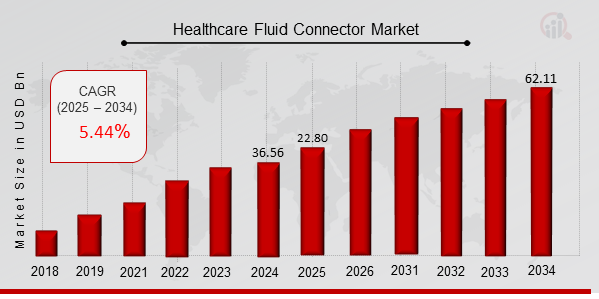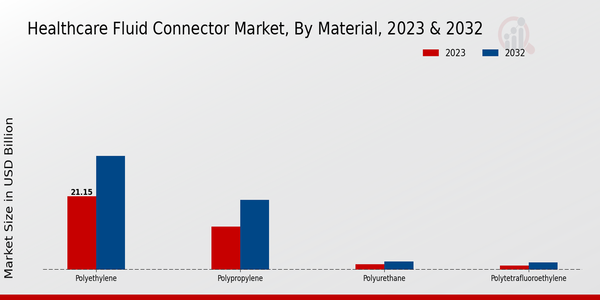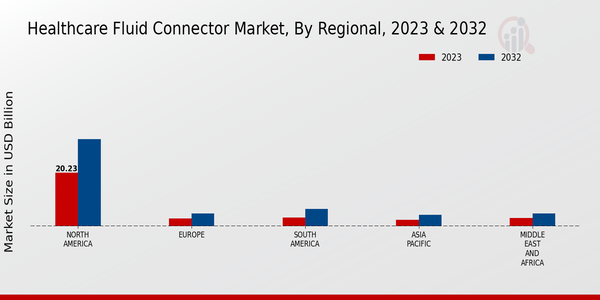Healthcare Fluid Connector Market Overview
As per MRFR analysis, the Healthcare Fluid Connector Market Size was estimated at 36.56 (USD Billion) in 2024. The Healthcare Fluid Connector Market Industry is expected to grow from 38.55 (USD Billion) in 2025 to 62.11 (USD Billion) till 2034, at a CAGR (growth rate) is expected to be around 5.44% during the forecast period (2025 - 2034).
Key Healthcare Fluid Connector Market Trends Highlighted
The Healthcare Fluid Connector Market is experiencing a surge in demand due to advancements in medical technology and increasing surgical procedures. The market is driven by the growing adoption of minimally invasive surgeries, which require precise and efficient fluid delivery systems.
The need for safe and reliable fluid management in critical care units and the rising prevalence of chronic diseases further contribute to market growth.
Recent trends in the healthcare fluid connector market include the integration of advanced materials and technologies. Biocompatible materials and antimicrobial coatings minimize the risk of infection and improve patient outcomes.
Smart connectors with embedded sensors allow for real-time monitoring of fluid flow, pressure, and temperature, enhancing patient safety and reducing the risk of complications.
Opportunities for growth in the healthcare fluid connector market lie in the development of innovative products and technologies that meet the evolving needs of healthcare providers.
Focus on sustainability and eco-friendly materials, as well as the integration of artificial intelligence and data analytics, will drive future market expansion.
 Source: Primary Research, Secondary Research, MRFR Database and Analyst Review
Source: Primary Research, Secondary Research, MRFR Database and Analyst Review
Healthcare Fluid Connector Market Drivers
Increasing Demand for Minimally Invasive Procedures
The growing adoption of minimally invasive surgical procedures is a major driver for the growth of the Healthcare Fluid Connector Market. Minimally invasive procedures, such as laparoscopy and endoscopy, require the use of specialized fluid connectors to safely and effectively deliver fluids and gases to the surgical site.
These procedures offer several advantages over traditional open surgeries, including reduced pain, scarring, and recovery time.
As the number of minimally invasive procedures performed worldwide continues to rise, the demand for healthcare fluid connectors is expected to increase in tandem. The market is witnessing a surge in demand for advanced and user-friendly fluid connectors that can withstand high pressures and deliver precise fluid flow rates.
These connectors play a crucial role in ensuring patient safety and procedural efficiency, contributing to the overall growth of the Healthcare Fluid Connector Market Industry.
Technological Advancements and Innovation
The healthcare fluid connector market is constantly evolving, driven by technological advancements and innovation. Manufacturers are continuously investing in research and development to improve the functionality, safety, and efficiency of their products.
New materials, such as biocompatible polymers and advanced plastics, are being utilized to enhance the durability and performance of fluid connectors. Additionally, the integration of smart technologies, such as sensors and microcontrollers, is enabling the development of intelligent fluid connectors that can monitor fluid flow rates, pressure, and temperature in real time.
These advancements are not only improving the quality of patient care but also creating new opportunities for growth in the Healthcare Fluid Connector Market Industry.
Growing Focus on Infection Prevention and Control
The increasing prevalence of healthcare-associated infections (HAIs) has led to a heightened focus on infection prevention and control measures. Fluid connectors play a critical role in preventing the spread of infections by providing a secure and sterile connection between medical devices and patients.
Manufacturers are developing innovative fluid connectors with built-in antimicrobial properties and advanced designs that minimize the risk of contamination.
These connectors help protect patients from infections, reduce the risk of complications, and improve overall patient outcomes. The growing awareness of infection prevention and control is expected to drive the demand for specialized fluid connectors in the Healthcare Fluid Connector Market Industry.
Healthcare Fluid Connector Market Segment Insights:
Healthcare Fluid Connector Market Material Insights
The Healthcare Fluid Connector Market is segmented based on material into Polyethylene (PE),
Polypropylene (PP), Polyurethane (PU), and Polytetrafluoroethylene (PTFE). Polyethylene (PE) is the most commonly used material in healthcare fluid connectors due to its low cost, flexibility, and chemical resistance.
PE is used in a wide range of applications, including intravenous (IV) bags, blood transfusion sets, and irrigation tubing. Polypropylene (PP) is another commonly used material in healthcare fluid connectors. PP is stronger and more resistant to heat than PE, making it suitable for use in applications where durability is important.
PP is often used in connectors for high-pressure applications, such as dialysis and respiratory therapy. Polyurethane (PU) is a versatile material that is used in a variety of healthcare fluid connectors. PU is strong, flexible, and biocompatible, making it suitable for use in applications where both durability and patient comfort are important.
PU is often used in connectors for catheters and other implantable devices. Polytetrafluoroethylene (PTFE) is a high-performance material that is used in healthcare fluid connectors where chemical resistance and low friction are important.
The growth of the market is attributed to the increasing demand for healthcare fluid connectors in various applications, such as drug delivery, blood transfusion, and fluid management. The rising prevalence of chronic diseases and the increasing number of surgical procedures are also contributing to the growth of the market.
 Source: Primary Research, Secondary Research, MRFR Database and Analyst Review
Source: Primary Research, Secondary Research, MRFR Database and Analyst Review
Healthcare Fluid Connector Market Type Insights
The Healthcare Fluid Connector Market is segmented by Type into Straight Connectors, Y-Type Connectors, T-Type Connectors, and Cross-Type Connectors. In 2023, the Straight Connectors segment held the largest market share of around 35%, owing to their widespread use in various medical applications such as fluid transfer, drug delivery, and blood transfusions.
Y-Type Connectors are projected to witness the fastest growth over the forecast period due to their increasing adoption in critical care settings for administering multiple fluids or medications simultaneously.
The market growth is attributed to the rising prevalence of chronic diseases, increasing demand for minimally invasive procedures, and technological advancements in healthcare fluid management systems.
Healthcare Fluid Connector Market Size Insights
The Healthcare Fluid Connector Market is segmented by size into small (1/4-inch diameter), medium (1/4-1/2-inch diameter), and large (>1/2-inch diameter). The market size is expected to reach USD 32.89 billion in 2023 and USD 52.98 billion by 2032, exhibiting a CAGR of 5.44% during the forecast period.
The growth of the market is attributed to the increasing demand for minimally invasive surgeries, the rising prevalence of chronic diseases, and the growing geriatric population. The small segment is anticipated to dominate the market throughout the forecast period.
This is primarily due to the widespread adoption of small-diameter fluid connectors in ambulatory surgical centers and clinics. Moreover, the increasing popularity of laparoscopic and robotic surgeries has further fueled the demand for small fluid connectors.
The medium segment is also expected to witness significant growth over the next decade. This is primarily due to the increasing adoption of medium-diameter fluid connectors in hospitals and surgical centers. The rising number of cardiovascular and orthopedic surgeries is expected to drive the demand for medium fluid connectors.
The large segment is expected to account for a smaller share of the market, but it is also anticipated to grow at a steady pace.
This is primarily due to the increasing demand for large-diameter fluid connectors in complex surgeries, such as cardiac and thoracic surgeries. The rising number of these surgeries is expected to fuel the growth of the large fluid connectors segment.
Healthcare Fluid Connector Market Application Insights
The Healthcare Fluid Connector Market revenue from the application segment is expected to grow significantly in the coming years. Intravenous therapy held the largest market share in 2023 and is expected to maintain its dominance throughout the forecast period.
The growth of this segment can be attributed to the increasing prevalence of chronic diseases, such as cancer and cardiovascular diseases, which require long-term intravenous drug administration. Blood transfusions are another major application segment, with a growing demand for blood transfusions in surgeries, trauma cases, and blood disorders.
Dialysis is also asignificant application, with the rising incidence of kidney diseases and the increasing number of dialysis procedures worldwide. Enteral nutrition, which involves the delivery of nutrients directly into the stomach or small intestine, is another important application segment driven by the growing number of patients with digestive disorders and malnutrition.
Respiratory therapy, which involves the delivery of oxygen or other respiratory medications through a fluid connector, is also a growing application segment due to the increasing prevalence of respiratory diseases, such as asthma and chronic obstructive pulmonary disease (COPD).
Healthcare Fluid Connector Market Target Market Insights
The target market for the Healthcare Fluid Connector Market consists of various healthcare facilities and providers, including hospitals, clinics, ambulatory surgical centers, home healthcare providers, and medical device manufacturers.
Hospitals account for a significant portion of the market due to the high volume of fluid administration procedures performed in these settings. The increasing prevalence of chronic diseases, rising demand for minimally invasive procedures, and technological advancements in fluid delivery systems are key factors driving market growth.
Healthcare Fluid Connector Market Regional Insights
The regional segmentation of the Healthcare Fluid Connector Market provides insights into the market's geographic distribution and performance. North America is expected to dominate the market in 2024, accounting for a significant share of the Healthcare Fluid Connector Market revenue.
The region's well-established healthcare infrastructure, increasing adoption of advanced medical technologies, and rising demand for minimally invasive procedures contribute to its dominance. Europe holds the second-largest market share, driven by government initiatives to improve healthcare systems and the presence of leading medical device manufacturers.
The Asia-Pacific (APAC) region is witnessing rapid market growth due to rising healthcare expenditure, increasing awareness of chronic diseases, and expanding medical tourism. South America and the Middle East and Africa (MEA) are emerging markets with potential for growth, supported by improving healthcare infrastructure and increasing healthcare spending.
 Source: Primary Research, Secondary Research, MRFR Database and Analyst Review
Source: Primary Research, Secondary Research, MRFR Database and Analyst Review
Healthcare Fluid Connector Market Key Players and Competitive Insights:
Major players in the Healthcare Fluid Connector Market industry are focusing on developing innovative products to meet the growing demand for minimally invasive procedures. Leading Healthcare Fluid Connector Market players are also investing in research and development to improve the performance and safety of their products.
The Healthcare Fluid Connector Market is expected to witness significant growth in the coming years, driven by the increasing adoption of minimally invasive procedures and the growing demand for safe and efficient fluid management solutions.
The competitive landscape of the Healthcare Fluid Connector Market is characterized by the presence of several global and regional players. Some of the key players operating in the market include Smiths Medical, Teleflex Incorporated, and BD. These companies are competing on the basis of product quality, innovation, and customer service.
Smiths Medical is a leading provider of medical devices and equipment. The company's product portfolio includes a wide range of fluid connectors, including luer connectors, stopcocks, and extension sets. Smiths Medical is known for its high-quality products and its commitment to innovation.
The company has a strong global presence and is a trusted supplier to hospitals and healthcare providers around the world.
Teleflex Incorporated is another major player in the Healthcare Fluid Connector Market. The company offers a comprehensive range of fluid connectors, including luer connectors, stopcocks, and extension sets.
Teleflex Incorporated is known for its innovative products and its ability to meet the needs of its customers. The company has a strong presence in North America and Europe and is expanding its reach into emerging markets.
Key Companies in the Healthcare Fluid Connector Market Include:
- Smiths Medical
- Terumo
- BD
- Medtronic
- Vygon
- Abbott Laboratories
- Codan
- Braun
- Boston Scientific
- NIPRO
- Fresenius Kabi
- Baxter
- Cardinal Health
- ICU Medical
- Teleflex
Healthcare Fluid Connector Market Industry Developments
The Healthcare Fluid Connector Market is anticipated to exhibit steady growth over the forecast period, driven by increasing demand for minimally invasive procedures, rising prevalence of chronic diseases, and technological advancements.
Key industry developments include the launch of innovative fluid connectors with enhanced safety features, strategic collaborations and acquisitions among market players, and a growing focus on disposable connectors to reduce infection risks.
Healthcare Fluid Connector Market Segmentation Insights
Healthcare Fluid Connector Market Material Outlook
- Polyethylene (PE)
- Polypropylene (PP)
- Polyurethane (PU)
- Polytetrafluoroethylene (PTFE)
Healthcare Fluid Connector Market Type Outlook
- Straight Connectors
- Y-Type Connectors
- T-Type Connectors
- Cross-Type Connectors
Healthcare Fluid Connector Market Size Outlook
- Small (1/4-inch diameter)
- Medium (1/4-1/2-inch diameter)
- Large (>1/2-inch diameter)
Healthcare Fluid Connector Market Application Outlook
- Intravenous Therapy
- Blood Transfusions
- Dialysis
- Enteral Nutrition
- Respiratory Therapy
Healthcare Fluid Connector Market Target Market Outlook
Healthcare Fluid Connector Market Regional Outlook
- North America
- Europe
- South America
- Asia Pacific
- Middle East and Africa
| Report Attribute/Metric |
Details |
|
Market Size 2024
|
36.56 (USD Billion)
|
|
Market Size 2025
|
38.55 (USD Billion)
|
|
Market Size 2034
|
62.11 (USD Billion)
|
|
Compound Annual Growth Rate (CAGR)
|
5.44 % (2025 - 2034)
|
|
Report Coverage
|
Revenue Forecast, Competitive Landscape, Growth Factors, and Trends
|
|
Base Year
|
2024
|
|
Market Forecast Period
|
2025 - 2034
|
|
Historical Data
|
2020 - 2024
|
| Market Forecast Units |
USD Billion |
| Key Companies Profiled |
Smiths Medical, Terumo, BD, Medtronic, Vygon, Abbott Laboratories, Codan, B. Braun, Boston Scientific, NIPRO, Fresenius Kabi, Baxter, Cardinal Health, ICU Medical, Teleflex |
| Segments Covered |
Material, Type, Size, Application, Target Market, Regional |
| Key Market Opportunities |
Emerging markets expansion Biocompatible materials innovation Wearable infusion devices Advanced connectivity solutions Telehealth integration |
| Key Market Dynamics |
Increasing minimally invasive surgeries, rising geriatric population, technological advancements, expanding healthcare infrastructure, and growing adoption of home healthcare |
| Countries Covered |
North America, Europe, APAC, South America, MEA |
Frequently Asked Questions (FAQ) :
The Healthcare Fluid Connector Market is expected to reach USD 62.11 billion by 2034, exhibiting a CAGR of 5.44% during the forecast period (2025-2034).
North America is expected to dominate the Healthcare Fluid Connector Market throughout the forecast period, owing to the presence of well-established healthcare infrastructure, increasing demand for minimally invasive procedures, and favorable reimbursement policies.
The rising prevalence of chronic diseases, increasing demand for minimally invasive procedures, technological advancements, and the growing geriatric population are the key factors driving the growth of the Healthcare Fluid Connector Market.
Healthcare fluid connectors are primarily used in various medical applications, including drug delivery, blood transfusion, IV therapy, and surgical procedures.
Some of the key competitors in the Healthcare Fluid Connector Market include Smiths Medical, Teleflex, Medtronic, Becton, Dickinson and Company, and ConvaTec Group.
Emerging economies, such as China and India, are expected to offer significant growth potential for the Healthcare Fluid Connector Market due to increasing healthcare spending, rising population, and growing demand for advanced healthcare technologies.
Stringent regulatory requirements, such as those imposed by the FDA and ISO, play a crucial role in ensuring the safety and efficacy of healthcare fluid connectors, influencing market dynamics and product development strategies.
Advancements in materials science, the rise of disposable and single-use connectors, and the integration of technology, such as RFID and sensors, are key trends shaping the Healthcare Fluid Connector Market.
The growing trend towards home healthcare is creating new opportunities for healthcare fluid connectors, as patients require reliable and convenient solutions for fluid delivery and monitoring in home settings.
Challenges in the Healthcare Fluid Connector Market include intense competition, stringent regulatory requirements, and the need for continuous innovation to meet evolving clinical needs.

















